HackTwat
MuscleChemistry Registered Member
A History Lesson In Bodybuilding
Find out how bodybuilding has evolved over the years, broken down by the different eras...
by David Robson Mar 21, 2005
<!-- end article-author-by-line --> <!-- Content from database --> The physical culture of muscle-building has attracted followers for many years; well before the advent of competitive bodybuilding as we know it today.
Followers of the iron game will know that bodybuilding in its popular form began in earnest in the 1890s with the arrival of Mr Eugene Sandow, of whom the Mr. Olympia statue is modelled on.
However, weight training, as a general athletic activity, was initially practiced as a means to gain strength and measure power in ancient Egyptian and Greek societies. These societies would primarily use stones of various sizes and weights (a practice that would occur, in one form or another throughout history) in their quest for bodily transformation. The celebration of the human body through muscular development was, in fact, one of the Greek ideals.
Physical culture (distinguishable from bodybuilding per se due to the lack of specific physical display as an end goal) can be traced back to 11th century India where stone dumbbell weights, known as Nals, were lifted by those wanting to develop their bodies to enhance health and stamina to help overcome the challenges of daily life. Gyms were commonplace in India during this period and by the 16th century weight training is thought to have been India's national pastime.
There was to be a long period between the 16th century physical movement in India and the beginning of bodybuilding (defined as training and dieting to develop one's body specifically for exhibitive purposes) as we know it today.
The Early Period//
1890-1929
Toward the end of the 19th century, weight-training took on a new meaning for many, as the ancient tradition of stone-lifting, practiced initially by the Greeks and Egyptians, made way for a completely new system of training, with a new end-goal. Weightlifting for entertainment purposes emerged in Europe signalling the beginning of a physical culture never before seen.
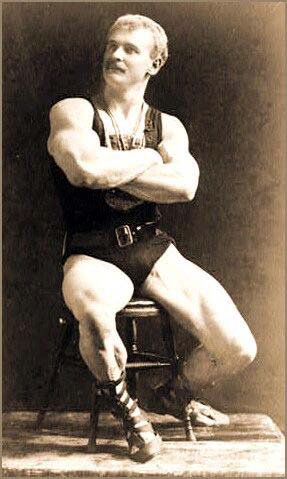 The intention was not to develop ones physique into a glorious spectacle per se, but to thrill crowds with amazing feats of strength - the professional strongman was the outcome of this intensified interest in weight-training. The modern sport, as it was becoming, of weight-lifting was somewhat of a natural evolution from the comparatively primitive practice of stone-lifting in dark, dank dungeons.
The intention was not to develop ones physique into a glorious spectacle per se, but to thrill crowds with amazing feats of strength - the professional strongman was the outcome of this intensified interest in weight-training. The modern sport, as it was becoming, of weight-lifting was somewhat of a natural evolution from the comparatively primitive practice of stone-lifting in dark, dank dungeons.
Not surprisingly, weightlifting exponentially grew in popularity so much so that today the practices during the early period of 1890 to 1929 would seem, at best, archaic. The practices of the late 19th century strongmen included issuing challenges to fellow strongmen to see who could outlift the other as they travelled from town to town.
Other practices included pulling carts and lifting animals, much to the amusement of onlookers. The public loved to watch these men compete, possibly for the novelty value if nothing else. How their physiques looked did not factor into these men's displays of physical prowess. Indeed, a protruding stomach and thick, fatty limbs were commonplace among these competitors.
Symmetry and aesthetics were a foreign concept at this point. However, as the 20th century approached, a man who was to bridge the gap between the overweight and unsightly strongman and the bodybuilder as we know him today was to emerge.
Officially know as the first famous bodybuilder and the father of modern bodybuilding, Eugene Sandow (born Friedric Muller), born 1867, immediately became a phenomenon with his unprecedented combination of muscle quality and strength. He became a turn-of-the-century physical cultural icon who is referred to as one of bodybuilding's greatest even in today's climate of genetic freaks.
Before the emergence of Sandow, proponents of physical culture were trying to find new ways to promote healthy lifestyles in line with the new phenomenon of weight-training for the sake of physical demonstration. Tired of the overweight strongman image with its lack of emphasis on correct eating and high body-fat levels, they were looking for a representative who could promote the chiseled physique, and the subsequent ways of achieving this look. They found their man in Sandow.
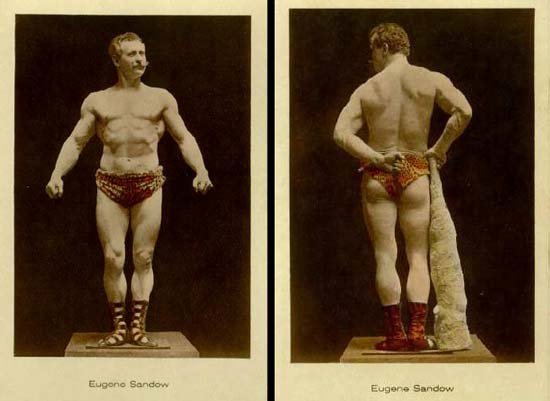
Eugene Sandow.
Sandow himself started out in Europe as a professional strongman, outdoing all other strongmen to make a name for himself. He travelled to America in the1890s to be billed as the worlds strongest man, travelling the country impressing people with his extraordinary feats of strength.
The most amazing thing about Sandow, however, was his beautifully symmetrical and densely muscular physique, which eventually positioned him as the first real bodybuilder and promoter of bodybuilding. Indeed, Sandow published the first bodybuilding magazine (Physical Culture), developed some of the first bodybuilding machinery, an appeared in numerous books and postcards, while continuing to tour America posing to sell-out audiences.
While Sandow continued to promote bodybuilding, weight-lifting contests were officially held for the first time with the World Championships and England in 1891. Weightlifting was also featured in the first modern Olympic Games in 1896, Athens Greece. Due to Sandow's influence, sales for barbells and dumbbells increased by a wide margin and a whole bodybuilding industry was created, with Sandow earning thousands of dollars a week.
Sadly, Sandow suffered a fatal brain hemorrhage when, according to legend, he tried to pull his car from a ditch in the interests of physical display. Sandow's legacy lives on in the increasing popularization of bodybuilding as a sport into the 21st century. Sandow judged the first bodybuilding contest ever held and his image is immortalized on the current Mr. Olympia statue.
The First Bodybuilding Contest
Ever Held
The first bodybuilding show, staged in 1891 and billed "The Great Show," was developed and promoted by none other than the great Eugene Sandow.
After popularizing bodybuilding though frequent strength exhibitions and posing displays across Europe and America, Sandow, 34, decided, after three-years of planning, that the time was right. He would provide all Sandow students in the U.K with the opportunity to display their physiques in a competition setting replete with a full judging panel and paying audience.
The contest was advertised three-years in advance in the first edition of Sandow's Magazine to promote the further spread of physical display and pride in one's physique. "To afford encouragement to those who are anxious to perfect their physiques," was the statement issued and many enthusiasts took this sentiment to heart as exemplified by the large turn-out of contestants and sell-out crowd of 2000.
The total prize money came to 1'000 guineas, which equated to more than $5,000 at the time. First place would receive the equivalent of $2,500 and a gold Sandow statuette, while second and third would take home silver and bronze statuettes respectively.
In order to compete in this contest of contests, all competitors first had to have placed in a smaller regional show (a bold move on Sandows part at the time). However, this system proved viable and on Saturday, September 14, 1901, England's Royal Albert Hall was packed to overflowing with spectators and competitors. Sandow believed in giving his audience their money's worth and provided various athletic displays as a form of pre-competition entertainment.
These displays included wrestling, gymnastics, and fencing and, at their completion, the real athletes, the bodybuilders, made their entrance. The bodybuilders, of which there were 60, marched to the beat of Sandow's own composition, The March of the Athletes, wearing the required costume: black tights, black jockey belt and leopard skins.
As for the physiques, the paying public were highly impressed. One journalist remarked "to stand in these men's ranks is a distinction."
The judging criteria was stringent and Sandow made it clear that points would be awarded for attributes other than sheer size. Indeed, Sandow was looking for symmetrically even development - the qualities that many say are overlooked in bodybuilding today.
The Qualities Sandow Looked For Were:
The man judged to have had the right combination of all of these qualities was William L Murray of Nottingham Great Britain, who took hame the gold Sandow and the title: Winner Of The World's First Big Bodybuilding Contest.
Following this contest, bodybuilding culture became increasingly widespread. Many entrepreneurs seized upon the notion of physical development and began distributing bodybuilding equipment and literature. Bernarr Macfadden, who became referred to as the father of physical culture, sold his popular chest expander and went on to become one of the greatest physical identities on the early 20th century.
<!--
 --> He published one of the first bodybuilding magazines, Physical Culture, and eventually became the most successful magazine publisher ever. In 1921, Macfadden helped to push another major protagonist for the physical movement in the form of Charles Atlas into the spotlight.
--> He published one of the first bodybuilding magazines, Physical Culture, and eventually became the most successful magazine publisher ever. In 1921, Macfadden helped to push another major protagonist for the physical movement in the form of Charles Atlas into the spotlight.
Well developed for that time, but smooth and underdeveloped by today's standards, Atlas (Real name Angelo Siciliano) became immensely popular and, through his standing as an expert on physical development, acquired the rights to a mail-order course called dynamic tension, an exercise system developed by Macfadden 20 years earlier.
The advertisements featuring the young man getting sand kicked into his face, only to retreat into a world of physical self-development, and eventually turn the tables on his bullying perpetrator, served as inspiration for many who took up bodybuilding upon seeing them. This advertisement is thought to be part of the most successful advertising campaign in history.
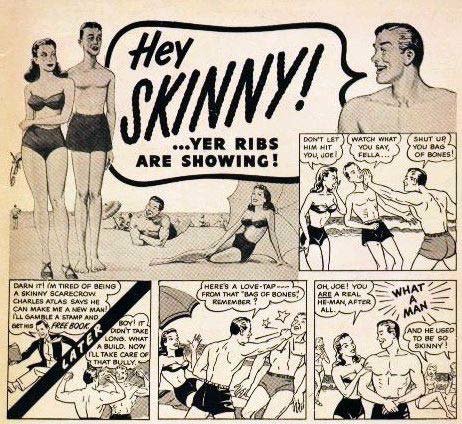
By the end of the 1920s, barbells, dumbbells and various other exercise devices were sold the world over as the general public grew to acknowledge the importance of becoming fit and strong. Famous bodybuilders were becoming household names and bodybuilding contests were being held frequently. Bodybuilding finally broke free of the association with weightlifting for the purposes of getting strong, and became, for many, a worthwhile pursuit in its own right.
The Culture Solidifies//
1930-1970s
As the bodybuilding movement progressed into the 1930s, adherents were becoming more interested in developing balanced physiques and losing body fat as training techniques and new developments in exercise equipment advanced. The 30s were the beginning of what is affectionately know as the golden age of bodybuilding, where gyms and the associated practices of training in groups and posing in front of mirrors become commonplace among followers.
On the California Coast, weightlifting on the beach front became popular among both amateur and professional bodybuilders. The most famous of these hangouts was situated in Santa Monica and called Muscle Beach.
Bodybuilding competition intensified when the AAU (the Amateur Athletic Union) established the Mr America in 1939, where participants, although not strictly bodybuilders, were required to demonstrate athletic skills. These competitors were advised to get into the best possible shape to increase their chances of winning, and the more they trained specifically to improve their bodies, the bigger the weight training emphasis became.
By 1940, the first modern bodybuilding event had arrived, the Mr America, which was won by John Grimek, who won it the following year also. Grimek, unparalleled in muscular development up until that point, became the catalyst for a new direction in physical improvement. As bodybuilding became more popular the quality of physique improved.
With physiques arguably more impressive than Grimek, Clancy Ross and Steve Reeves made their mark in the 40s. Ross won the America in 1945 and many believe him to have been the first modern bodybuilder, although at this time bodybuilding was still regarded with scepticism by many.
However, Steve Reeves came along and further popularised bodybuilding due to his movie star looks and perfectly proportioned physique. Reeves eventually became revered as the greatest bodybuilder of all time after winning the Mr America and the Mr Universe (the other big contest to have sprung up in light of the success of the America). He went on to become one of the first heroic movie stars gaining a fan base of thousands.
Other bodybuilders, such as Reg Park, followed Reeves example and became great champions. Bodybuilding was truly developing at an exponential rate with the IFBB (the International Federation of Bodybuilders) being formed by Ben Weider in 1946 and NABBA (the National Amateur Bodybuilders Association) being formed in England in 1950.
The first large-scale bodybuilding competitions were held by these organizations: the Mr. Olympia in 1965 by the IFBB and the Mr Universe in 1950 by NABBA. The 1960s marked the period the most influential bodybuilder of all time would make his mark. Arnold Schwarzenegger beat Dennis Tinereno for the Mr America title in 1967 and immediately began dominating the international competition. He would go on to win the Universe on five occasions and Mr. Olympia seven times.
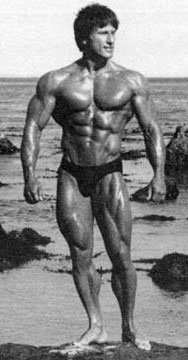
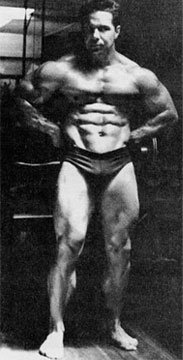
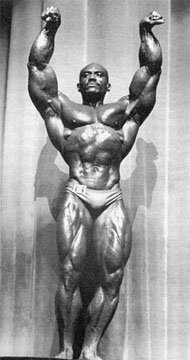
The Great Frank Zane, Bill Pearl & Sergio Oliva.
The Mr. Olympia had been won first by Larry Scott in 1965, who went on to win again in 66. Sergio Oliva won in 1967, 68 and 69. Arnold cemented his spot as the number one bodybuilder in the world by winning the Olympia for the next five years straight and again in 1980. He would also conquer the movie world, earning a Hollywood star.
As bodybuilding increased in popularity into the 1970s, Arnold and other superstars such as three-time Mr. Olympia winner Frank Zane, Dave Draper and Mike Mentzer became household names. The movie industry often specifically targeted muscular actors such was the marketability of this type of physique. As the muscular body became more desirable, the gym industry gained momentum and the industry as a whole became lucrative.
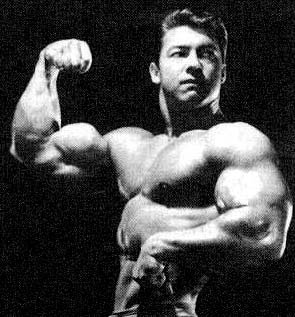
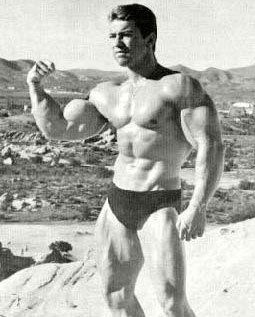
The One, The Only - Larry Scott.
In the 1970s, the IFBB rose to prominence as the dominant bodybuilding organisation. Toward the end of this period, the IFBB consisted of more than 100 member countries and had become the sixth largest sporting federation in the world.
Bodybuilding was regarded as a legitimate sport, had become a multi-billion-dollar-industry and had adherents in all major countries.
Bodybuilding's Recent History//
1980-Present Time
By the 1980s, bodybuilding had become a popular sport with great cross-over appeal. Film stars and athletes from many sports were increasingly using bodybuilding to improve their marketability and performance. Actors like Sylvester Stallone (Editor's Note: Check back soon for an inteview with Stallone!) and Chuck Norris had become noticeably more muscular as had athletes Ben Johnson and Carl Lewis, for example.
The practices of weight-training and dieting, so central to the bodybuilding ethos, had clearly been adopted by mainstream society to increase profile and enhance performance.
Competitive bodybuilders were also becoming more muscular as an increasing emphasis on size dictated a more extreme approach to physical development. Anabolic steroids had been used during the 60s, and their use correspondingly increased as bodybuilding grew in popularity.
Prize money, sponsorships and endorsements had increased due to the growth of the bodybuilding industry and had become a major motivating factor for many entering the sport.
A general trend in aesthetics and balance gave way to a mass at all costs approach and top place getters generally were those carrying the most size, especially into the 90s and beyond 2000.
Although steroids were used prior to the 80s, the stacking of various types of steroid (using more than one at any one time) and use of dangerous growth hormones and insulin were becoming commonplace as the 80s drew to a close. Amateurs and professionals alike engaged in this disturbing trend with the intention of making a name for themselves and increasing their earning potential.
Indeed, with the increase in competing bodybuilders came increased competition among these athletes. This would mean a great bodybuilder would have to become greater to distance themselves from the closest rival, who would be taking the same extreme approach to developing their physique.
As the 90s approached, the quality of physique improved due to advances in training techniques, dietary strategies and, yes, drugs. The 80s witnessed the rise of Lee Haney, who won seven Mr. Olympia's. His physique at around 240lbs had surpassed any other bodybuilder up until that point.
When he retired, Haney had beaten Arnolds record of six Olympia's and, in the eyes of many, surpassed him in terms of muscular development.
Other notable bodybuilders of this period were Lee Labrada, (one of the few successful under 200lb professional bodybuilders due to his classical symmetry and presentation skills), Vince Taylor, Shawn Ray and Mike Quinn. Shawn Ray would go on to compete throughout the 90s, placing highly in every Olympia he entered.
The 90s could truly be defined as the era where competitors demonstrated a leap forward in terms of muscle mass. Dorian Yates won five Mr. Olympia's (between 1992 and 1997) and heralded a new benchmark in mass at 265 pounds ripped.
In fact, all professional bodybuilders of this era demonstrated a distinctly different, more massively defined, physique to that of the 80s, as extreme practices prevailed. And just when everyone thought that Yates had redefined the massive physique, along came a man who would surpass him by at least 20 pounds.
Current Mr. Olympia Ronnie Coleman routinely competes at around 290lbs and has taken the competition physique beyond what was, up until 10 years ago, thought possible. Co-competitors Jay Cutler and Dexter Jackson also compete light years ahead of anything seen throughout the 80s and 90s.
Legendary bodybuilder Arnold Schwarzenegger played an active role in bodybuilding's development throughout the 90s and beyond. He began promoting the Arnold Schwarzenegger Classic bodybuilding championships in 1989, a contest that gradually incorporated other fitness-related events to become one of the most popular athletic events in the world.
In the 90s, Arnold became the Chairman for the Presidents Council on Fitness and used bodybuilding-related practices to inspire the American public to get fit and active.
Bodybuilding also became popularized through various media publications, most notably Muscle and Fitness (spawned from 60s publication Muscle Builder and Power) which hit the stands in 1980 and its offshoot Flex magazine, released in 1983. Originally owned by Weider Publications, these magazines are now under the ownership of America Media Inc (AMI), who also publish the National enquire and Star (Read the full story here).
The fact that a media company the size of AMI have bought these publications underscores the monumental impact bodybuilding has made since its inception. These publications continue to promulgate the bodybuilding lifestyle while promoting the current crop of champions who continue to inspire many to begin the quest for physical perfection.
In 2004, Arnold Schwarzenegger became the executive editor of both Muscle and Fitness and Flex Magazine, magazines he appeared on the cover of 30 and 20 times respectively.
Media across the board have seized the opportunity to capitalize on bodybuilding's success. Pay-per-view have broadcast the Mr. Olympia while programs promoting the bodybuilding lifestyle such as Cory Everson's show on ESPN gained momentum.
The Internet has also exploded with thousand of bodybuilding sites, many very professionally done, with worldwide followings. Bodybuilding.com ranks as probably the biggest and best of these, with thousand of articles and information on all aspects of the sport.
Bodybuilding clearly has come a long way since its primitive beginnings, back in the early 1890s. It popularity can not be denied and it will continue to grow if its current rate of growth is anything to go by. However, with the number of professional shows increasing coupled with the availability of an increasing array of sophisticated performance enhancing drugs (and other substances such as synthanol and implants (Lou Feriggno) the actual sport of bodybuilding will probably continue to be characterized as a curiosity of physical extremes.
On the other hand, bodybuilding also has a growing natural movement where competitors compete free of potentially harmful substances and enjoy corresponding health benefits.
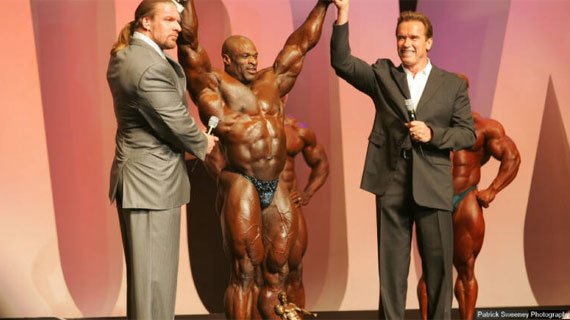
Arnold at the 2004 Mr. Olympia contest with Ronnie Coleman.
Ultimately, the practices of weight-training and eating a balanced diet, central to bodybuilding success at all levels, will enhance the lives of many. In this respect, bodybuilding can be seen in a positive light, as a beneficial sport.
On the competitive side, many bodybuilders will continue to use drugs to enhance their chances of winning. As to the future of the sport, time will tell.
References
Find out how bodybuilding has evolved over the years, broken down by the different eras...
by David Robson Mar 21, 2005
<!-- end article-author-by-line --> <!-- Content from database --> The physical culture of muscle-building has attracted followers for many years; well before the advent of competitive bodybuilding as we know it today.
Followers of the iron game will know that bodybuilding in its popular form began in earnest in the 1890s with the arrival of Mr Eugene Sandow, of whom the Mr. Olympia statue is modelled on.
However, weight training, as a general athletic activity, was initially practiced as a means to gain strength and measure power in ancient Egyptian and Greek societies. These societies would primarily use stones of various sizes and weights (a practice that would occur, in one form or another throughout history) in their quest for bodily transformation. The celebration of the human body through muscular development was, in fact, one of the Greek ideals.
Physical culture (distinguishable from bodybuilding per se due to the lack of specific physical display as an end goal) can be traced back to 11th century India where stone dumbbell weights, known as Nals, were lifted by those wanting to develop their bodies to enhance health and stamina to help overcome the challenges of daily life. Gyms were commonplace in India during this period and by the 16th century weight training is thought to have been India's national pastime.
There was to be a long period between the 16th century physical movement in India and the beginning of bodybuilding (defined as training and dieting to develop one's body specifically for exhibitive purposes) as we know it today.
The Early Period//
1890-1929
Toward the end of the 19th century, weight-training took on a new meaning for many, as the ancient tradition of stone-lifting, practiced initially by the Greeks and Egyptians, made way for a completely new system of training, with a new end-goal. Weightlifting for entertainment purposes emerged in Europe signalling the beginning of a physical culture never before seen.

Not surprisingly, weightlifting exponentially grew in popularity so much so that today the practices during the early period of 1890 to 1929 would seem, at best, archaic. The practices of the late 19th century strongmen included issuing challenges to fellow strongmen to see who could outlift the other as they travelled from town to town.
Other practices included pulling carts and lifting animals, much to the amusement of onlookers. The public loved to watch these men compete, possibly for the novelty value if nothing else. How their physiques looked did not factor into these men's displays of physical prowess. Indeed, a protruding stomach and thick, fatty limbs were commonplace among these competitors.
Symmetry and aesthetics were a foreign concept at this point. However, as the 20th century approached, a man who was to bridge the gap between the overweight and unsightly strongman and the bodybuilder as we know him today was to emerge.
Officially know as the first famous bodybuilder and the father of modern bodybuilding, Eugene Sandow (born Friedric Muller), born 1867, immediately became a phenomenon with his unprecedented combination of muscle quality and strength. He became a turn-of-the-century physical cultural icon who is referred to as one of bodybuilding's greatest even in today's climate of genetic freaks.
Before the emergence of Sandow, proponents of physical culture were trying to find new ways to promote healthy lifestyles in line with the new phenomenon of weight-training for the sake of physical demonstration. Tired of the overweight strongman image with its lack of emphasis on correct eating and high body-fat levels, they were looking for a representative who could promote the chiseled physique, and the subsequent ways of achieving this look. They found their man in Sandow.

Eugene Sandow.
Sandow himself started out in Europe as a professional strongman, outdoing all other strongmen to make a name for himself. He travelled to America in the1890s to be billed as the worlds strongest man, travelling the country impressing people with his extraordinary feats of strength.
The most amazing thing about Sandow, however, was his beautifully symmetrical and densely muscular physique, which eventually positioned him as the first real bodybuilder and promoter of bodybuilding. Indeed, Sandow published the first bodybuilding magazine (Physical Culture), developed some of the first bodybuilding machinery, an appeared in numerous books and postcards, while continuing to tour America posing to sell-out audiences.
While Sandow continued to promote bodybuilding, weight-lifting contests were officially held for the first time with the World Championships and England in 1891. Weightlifting was also featured in the first modern Olympic Games in 1896, Athens Greece. Due to Sandow's influence, sales for barbells and dumbbells increased by a wide margin and a whole bodybuilding industry was created, with Sandow earning thousands of dollars a week.
Sadly, Sandow suffered a fatal brain hemorrhage when, according to legend, he tried to pull his car from a ditch in the interests of physical display. Sandow's legacy lives on in the increasing popularization of bodybuilding as a sport into the 21st century. Sandow judged the first bodybuilding contest ever held and his image is immortalized on the current Mr. Olympia statue.
The First Bodybuilding Contest
Ever Held
The first bodybuilding show, staged in 1891 and billed "The Great Show," was developed and promoted by none other than the great Eugene Sandow.
After popularizing bodybuilding though frequent strength exhibitions and posing displays across Europe and America, Sandow, 34, decided, after three-years of planning, that the time was right. He would provide all Sandow students in the U.K with the opportunity to display their physiques in a competition setting replete with a full judging panel and paying audience.
The contest was advertised three-years in advance in the first edition of Sandow's Magazine to promote the further spread of physical display and pride in one's physique. "To afford encouragement to those who are anxious to perfect their physiques," was the statement issued and many enthusiasts took this sentiment to heart as exemplified by the large turn-out of contestants and sell-out crowd of 2000.
The total prize money came to 1'000 guineas, which equated to more than $5,000 at the time. First place would receive the equivalent of $2,500 and a gold Sandow statuette, while second and third would take home silver and bronze statuettes respectively.
In order to compete in this contest of contests, all competitors first had to have placed in a smaller regional show (a bold move on Sandows part at the time). However, this system proved viable and on Saturday, September 14, 1901, England's Royal Albert Hall was packed to overflowing with spectators and competitors. Sandow believed in giving his audience their money's worth and provided various athletic displays as a form of pre-competition entertainment.
These displays included wrestling, gymnastics, and fencing and, at their completion, the real athletes, the bodybuilders, made their entrance. The bodybuilders, of which there were 60, marched to the beat of Sandow's own composition, The March of the Athletes, wearing the required costume: black tights, black jockey belt and leopard skins.
As for the physiques, the paying public were highly impressed. One journalist remarked "to stand in these men's ranks is a distinction."
The judging criteria was stringent and Sandow made it clear that points would be awarded for attributes other than sheer size. Indeed, Sandow was looking for symmetrically even development - the qualities that many say are overlooked in bodybuilding today.
The Qualities Sandow Looked For Were:
- General development.
- Equality or balance of development.
- The condition and tone of the tissues.
- General health.
- Condition of the skin.
The man judged to have had the right combination of all of these qualities was William L Murray of Nottingham Great Britain, who took hame the gold Sandow and the title: Winner Of The World's First Big Bodybuilding Contest.
Following this contest, bodybuilding culture became increasingly widespread. Many entrepreneurs seized upon the notion of physical development and began distributing bodybuilding equipment and literature. Bernarr Macfadden, who became referred to as the father of physical culture, sold his popular chest expander and went on to become one of the greatest physical identities on the early 20th century.
<!--

Well developed for that time, but smooth and underdeveloped by today's standards, Atlas (Real name Angelo Siciliano) became immensely popular and, through his standing as an expert on physical development, acquired the rights to a mail-order course called dynamic tension, an exercise system developed by Macfadden 20 years earlier.
The advertisements featuring the young man getting sand kicked into his face, only to retreat into a world of physical self-development, and eventually turn the tables on his bullying perpetrator, served as inspiration for many who took up bodybuilding upon seeing them. This advertisement is thought to be part of the most successful advertising campaign in history.

By the end of the 1920s, barbells, dumbbells and various other exercise devices were sold the world over as the general public grew to acknowledge the importance of becoming fit and strong. Famous bodybuilders were becoming household names and bodybuilding contests were being held frequently. Bodybuilding finally broke free of the association with weightlifting for the purposes of getting strong, and became, for many, a worthwhile pursuit in its own right.
The Culture Solidifies//
1930-1970s
As the bodybuilding movement progressed into the 1930s, adherents were becoming more interested in developing balanced physiques and losing body fat as training techniques and new developments in exercise equipment advanced. The 30s were the beginning of what is affectionately know as the golden age of bodybuilding, where gyms and the associated practices of training in groups and posing in front of mirrors become commonplace among followers.
On the California Coast, weightlifting on the beach front became popular among both amateur and professional bodybuilders. The most famous of these hangouts was situated in Santa Monica and called Muscle Beach.
Bodybuilding competition intensified when the AAU (the Amateur Athletic Union) established the Mr America in 1939, where participants, although not strictly bodybuilders, were required to demonstrate athletic skills. These competitors were advised to get into the best possible shape to increase their chances of winning, and the more they trained specifically to improve their bodies, the bigger the weight training emphasis became.
By 1940, the first modern bodybuilding event had arrived, the Mr America, which was won by John Grimek, who won it the following year also. Grimek, unparalleled in muscular development up until that point, became the catalyst for a new direction in physical improvement. As bodybuilding became more popular the quality of physique improved.
With physiques arguably more impressive than Grimek, Clancy Ross and Steve Reeves made their mark in the 40s. Ross won the America in 1945 and many believe him to have been the first modern bodybuilder, although at this time bodybuilding was still regarded with scepticism by many.
However, Steve Reeves came along and further popularised bodybuilding due to his movie star looks and perfectly proportioned physique. Reeves eventually became revered as the greatest bodybuilder of all time after winning the Mr America and the Mr Universe (the other big contest to have sprung up in light of the success of the America). He went on to become one of the first heroic movie stars gaining a fan base of thousands.
Other bodybuilders, such as Reg Park, followed Reeves example and became great champions. Bodybuilding was truly developing at an exponential rate with the IFBB (the International Federation of Bodybuilders) being formed by Ben Weider in 1946 and NABBA (the National Amateur Bodybuilders Association) being formed in England in 1950.
The first large-scale bodybuilding competitions were held by these organizations: the Mr. Olympia in 1965 by the IFBB and the Mr Universe in 1950 by NABBA. The 1960s marked the period the most influential bodybuilder of all time would make his mark. Arnold Schwarzenegger beat Dennis Tinereno for the Mr America title in 1967 and immediately began dominating the international competition. He would go on to win the Universe on five occasions and Mr. Olympia seven times.



The Great Frank Zane, Bill Pearl & Sergio Oliva.
The Mr. Olympia had been won first by Larry Scott in 1965, who went on to win again in 66. Sergio Oliva won in 1967, 68 and 69. Arnold cemented his spot as the number one bodybuilder in the world by winning the Olympia for the next five years straight and again in 1980. He would also conquer the movie world, earning a Hollywood star.
As bodybuilding increased in popularity into the 1970s, Arnold and other superstars such as three-time Mr. Olympia winner Frank Zane, Dave Draper and Mike Mentzer became household names. The movie industry often specifically targeted muscular actors such was the marketability of this type of physique. As the muscular body became more desirable, the gym industry gained momentum and the industry as a whole became lucrative.


The One, The Only - Larry Scott.
In the 1970s, the IFBB rose to prominence as the dominant bodybuilding organisation. Toward the end of this period, the IFBB consisted of more than 100 member countries and had become the sixth largest sporting federation in the world.
Bodybuilding was regarded as a legitimate sport, had become a multi-billion-dollar-industry and had adherents in all major countries.
Bodybuilding's Recent History//
1980-Present Time
By the 1980s, bodybuilding had become a popular sport with great cross-over appeal. Film stars and athletes from many sports were increasingly using bodybuilding to improve their marketability and performance. Actors like Sylvester Stallone (Editor's Note: Check back soon for an inteview with Stallone!) and Chuck Norris had become noticeably more muscular as had athletes Ben Johnson and Carl Lewis, for example.
The practices of weight-training and dieting, so central to the bodybuilding ethos, had clearly been adopted by mainstream society to increase profile and enhance performance.
Competitive bodybuilders were also becoming more muscular as an increasing emphasis on size dictated a more extreme approach to physical development. Anabolic steroids had been used during the 60s, and their use correspondingly increased as bodybuilding grew in popularity.
Prize money, sponsorships and endorsements had increased due to the growth of the bodybuilding industry and had become a major motivating factor for many entering the sport.
A general trend in aesthetics and balance gave way to a mass at all costs approach and top place getters generally were those carrying the most size, especially into the 90s and beyond 2000.
Although steroids were used prior to the 80s, the stacking of various types of steroid (using more than one at any one time) and use of dangerous growth hormones and insulin were becoming commonplace as the 80s drew to a close. Amateurs and professionals alike engaged in this disturbing trend with the intention of making a name for themselves and increasing their earning potential.
Indeed, with the increase in competing bodybuilders came increased competition among these athletes. This would mean a great bodybuilder would have to become greater to distance themselves from the closest rival, who would be taking the same extreme approach to developing their physique.
As the 90s approached, the quality of physique improved due to advances in training techniques, dietary strategies and, yes, drugs. The 80s witnessed the rise of Lee Haney, who won seven Mr. Olympia's. His physique at around 240lbs had surpassed any other bodybuilder up until that point.
When he retired, Haney had beaten Arnolds record of six Olympia's and, in the eyes of many, surpassed him in terms of muscular development.
Other notable bodybuilders of this period were Lee Labrada, (one of the few successful under 200lb professional bodybuilders due to his classical symmetry and presentation skills), Vince Taylor, Shawn Ray and Mike Quinn. Shawn Ray would go on to compete throughout the 90s, placing highly in every Olympia he entered.
The 90s could truly be defined as the era where competitors demonstrated a leap forward in terms of muscle mass. Dorian Yates won five Mr. Olympia's (between 1992 and 1997) and heralded a new benchmark in mass at 265 pounds ripped.
In fact, all professional bodybuilders of this era demonstrated a distinctly different, more massively defined, physique to that of the 80s, as extreme practices prevailed. And just when everyone thought that Yates had redefined the massive physique, along came a man who would surpass him by at least 20 pounds.
Current Mr. Olympia Ronnie Coleman routinely competes at around 290lbs and has taken the competition physique beyond what was, up until 10 years ago, thought possible. Co-competitors Jay Cutler and Dexter Jackson also compete light years ahead of anything seen throughout the 80s and 90s.
Legendary bodybuilder Arnold Schwarzenegger played an active role in bodybuilding's development throughout the 90s and beyond. He began promoting the Arnold Schwarzenegger Classic bodybuilding championships in 1989, a contest that gradually incorporated other fitness-related events to become one of the most popular athletic events in the world.
In the 90s, Arnold became the Chairman for the Presidents Council on Fitness and used bodybuilding-related practices to inspire the American public to get fit and active.
Bodybuilding also became popularized through various media publications, most notably Muscle and Fitness (spawned from 60s publication Muscle Builder and Power) which hit the stands in 1980 and its offshoot Flex magazine, released in 1983. Originally owned by Weider Publications, these magazines are now under the ownership of America Media Inc (AMI), who also publish the National enquire and Star (Read the full story here).
The fact that a media company the size of AMI have bought these publications underscores the monumental impact bodybuilding has made since its inception. These publications continue to promulgate the bodybuilding lifestyle while promoting the current crop of champions who continue to inspire many to begin the quest for physical perfection.
In 2004, Arnold Schwarzenegger became the executive editor of both Muscle and Fitness and Flex Magazine, magazines he appeared on the cover of 30 and 20 times respectively.
Media across the board have seized the opportunity to capitalize on bodybuilding's success. Pay-per-view have broadcast the Mr. Olympia while programs promoting the bodybuilding lifestyle such as Cory Everson's show on ESPN gained momentum.
The Internet has also exploded with thousand of bodybuilding sites, many very professionally done, with worldwide followings. Bodybuilding.com ranks as probably the biggest and best of these, with thousand of articles and information on all aspects of the sport.
Bodybuilding clearly has come a long way since its primitive beginnings, back in the early 1890s. It popularity can not be denied and it will continue to grow if its current rate of growth is anything to go by. However, with the number of professional shows increasing coupled with the availability of an increasing array of sophisticated performance enhancing drugs (and other substances such as synthanol and implants (Lou Feriggno) the actual sport of bodybuilding will probably continue to be characterized as a curiosity of physical extremes.
On the other hand, bodybuilding also has a growing natural movement where competitors compete free of potentially harmful substances and enjoy corresponding health benefits.

Arnold at the 2004 Mr. Olympia contest with Ronnie Coleman.
Ultimately, the practices of weight-training and eating a balanced diet, central to bodybuilding success at all levels, will enhance the lives of many. In this respect, bodybuilding can be seen in a positive light, as a beneficial sport.
On the competitive side, many bodybuilders will continue to use drugs to enhance their chances of winning. As to the future of the sport, time will tell.
References
- Schwarzenegger, (1999).The New Encyclopaedia of Modern Bodybuilding. Fireside, NY.
- History of Bodybuilding. (2004). Bodybuilding History. [Online]
- Oldenburg, A.(2004). Editor Arnold: He's nothing if not flexible. USA Today. Gannett Co INC.

